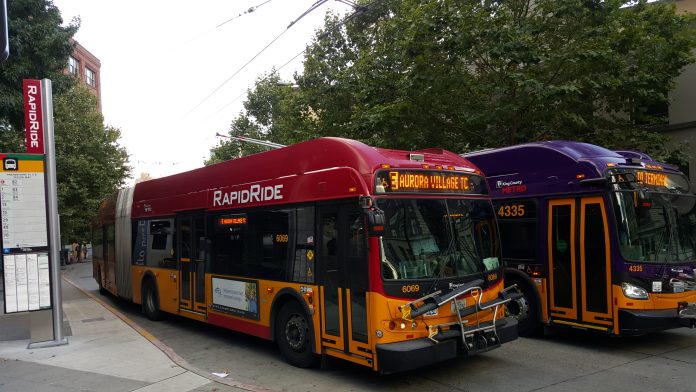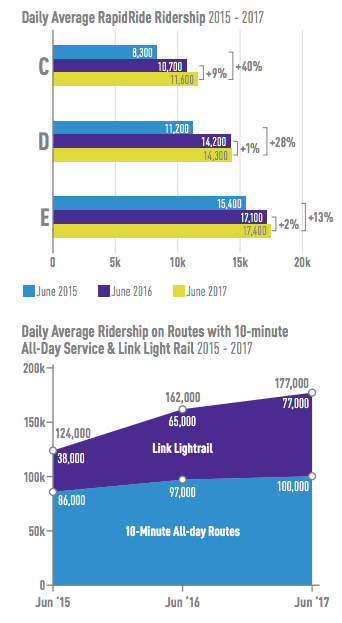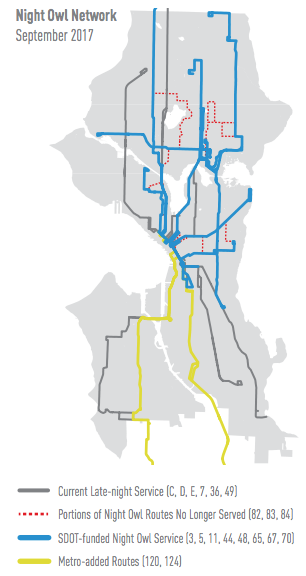The second year of the Seattle Transit Benefit District (STBD) showed very positive results delivering increasing ridership, more local bus service, and overall system improvements. The STBD is now in its third year. So the question is what comes next? Last week, I spoke to Andrew Glass-Hastings, Transit and Mobility Director for the Seattle Department of Transportation (SDOT), to find out.
The first topic we discussed was ridership demand. “We can’t add the service fast enough,” Glass-Hastings said. Ridership data confirms this with demand growing quickly from 86,000 to 100,000 daily rides on frequent transit service routes (these are routes where buses arrive at least every 10 minutes) over a two year period. Taken in the context that the metric doesn’t even include Link light rail, which was extended to Capitol Hill and the University of Washington in 2016, the 16.2% ridership growth on frequent transit service alone is astounding.
Glass-Hastings said that the city needs to keep meeting demand during peak periods. Investments in service during peak periods is paying dividends with riders responding by filling up many of the extra trips once they’re added. This phenomenon has been particularly prominent on RapidRide corridors where some trips come as frequently as every four or five minutes. SDOT investment in the corridors has made these higher end frequencies possible.
However, Glass-Hastings noted that the city is fortunate it “[doesn’t] have to pick winners and losers” for transit service improvements. He said that SDOT could achieve long-term goals for frequent transit service, implement seven new RapidRide corridors, further expand Night Owl Network service, and address peak crowding at the same time. The biggest impediment with service, Glass-Hastings said, was hiring more transit operators to drive Metro routes. King County Metro Transit is in a hiring frenzy right now and training many new operators.
Turning to the future of the STBD, which is funded by a $60 vehicle license and 0.1% sales tax set to expire in 2020, Glass-Hastings acknowledged that some level of city funding will likely be necessary to sustain local bus service. Seattle has higher transit service needs and expectations than much of the county. So while King County funds a baseline level of service, the city is backing more than 30% of trips on many city routes and bankrolls more than 308,000 annual service hours.
One option that could partially or fulfill much of the role that the STBD is providing would be a countywide funding source. That could come in many different forms to sustain the levels of transit service now operating in Seattle and expand service outside of the city. That seems necessary if Metro’s long-range transit plan, Metro Connects, is to be realized. But regardless, the city likely will continue to have unique needs that well exceed those of the county. Glass-Hastings said the city will need to go through a planning process before 2020 with the public and Metro to determine if a similar measure should be put before voters and what priorities should be built into it.
In September, Metro and SDOT unveiled a new Night Owl Network to improve the function, coverage, span of service, and frequency for late night transit. Glass-Hastings expressed optimism of the reformed network explaining that SDOT expects ridership in the late-night bus network to grow and realize the goal of a truly 24/7 system similar to Vancouver and Los Angeles.
Most of the expanded Night Owl Network was made possible by funding from the STBD. Routes 82, 83, and 84–circuitous one-way artifacts of the old Night Owl Network–were deleted in favor of extended service on Routes 3, 5, 11, 44, 48, 65, 67, and 70. Some of these routes now allow out-of-downtown connections between routes and expand the overall reach of the Night Owl Network. King County Metro Transit also added service on Routes 120 and 124 providing better service in West Seattle, Georgetown, South Park, and to Sea-Tac Airport.
The Night Owl Network will see improvements in the next few years with seven new RapidRide lines to be deployed. Most of the Night Owl routes come every 30 minutes or less until about 2am and then about hourly until 5am. SDOT will assess how the network is performing, Glass-Hasting said, and may make improvements in the margins such as increasing frequencies on routes, perhaps as frequent as every half hour or better which is the goal.
Rounding out our discussion was pedestrian amenities. Glass-Hastings said that pedestrian facilities and amenities are one of the most important aspects of operating transit since they link riders to buses. As a bit of a blessing and curse, transit service is now reaching places where pedestrian facilities are often substandard or lacking. Glass-Hastings emphasized the role that spot improvements can play in helping to connect riders on foot with transit stops. Many of these are specified in the Pedestrian Master Plan (PMP) with dollars coming from a variety of sources, but are admittedly a long way off. Still, the PMP’s Priority Investment Network–the highest priority streets for pedestrian improvements–places an emphasis on building out pedestrian facilities in proximity to bus corridors, particularly existing and planned high frequency corridors.
The SDOT Transit and Mobility Division has a limited pot of money available for pedestrian improvements with much of it going toward things like rear door pads and minor bus stop amenities that improve rider experience and provide service efficiency. Wider pedestrian improvements tend to be implemented as part of corridor projects associated with RapidRide, such as curb ramps, extended and new sidewalks, off-board payment, and enhanced bus shelters. However, SDOT has done various corridor projects in the past like Dexter Ave N, N/NE 45th St, and Roosevelt Way NE that have greatly improve pedestrian access, safety, and experience outside of RapidRide.
Looking ahead, Glass-Hastings mentioned that SDOT is slated to move forward bus stop modernization on Third Avenue. Bus stops will generally feel lighter, sleeker, and more welcoming for riders and be similar to those found in cities like Vancouver, Cork City, and Paris.
Ultimately, the big takeaway from my discussion with Glass-Hastings is that Seattle has a bright transit future ahead of it and SDOT intends to ensure that taxpayers and riders get positive results from the city’s investments in transit. The third year of the STBD hopefully will continue to deliver new service and rider improvements.
Stephen is a professional urban planner in Puget Sound with a passion for sustainable, livable, and diverse cities. He is especially interested in how policies, regulations, and programs can promote positive outcomes for communities. With stints in great cities like Bellingham and Cork, Stephen currently lives in Seattle. He primarily covers land use and transportation issues and has been with The Urbanist since 2014.




